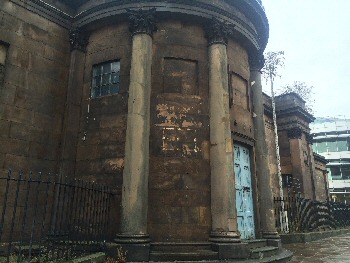|
New plan for historic
Wellington Rooms

DISCUSSIONS are underway about
restoring the much loved historic Wellington Rooms in Liverpool and bringing it
back into use.
The Grade II listed building; originally used for high society dance balls when
it opened in 1816 and latterly known as the City's Irish Centre; is situated on
Mount Pleasant, in the City Centre. It closed in 1997 and subsequent regeneration
proposals have failed to get off the ground.
Plans were approved for the Wellington Rooms to become a function suite in 2002,
but never implemented, while application for it to become a hotel in 2006 and
2007 was rejected because of the detrimental impact of a three storey extension.
Now the University of Liverpool has begun working with Merseyside Building
Preservation Trust and Liverpool City Council on a feasibility study which could
see it brought back into use as an innovation hub to give students enterprise
and entrepreneurship training, and provide office space to help new businesses
develop.
Stephen Holloway, Pro Vice Chancellor of the University of Liverpool, said:-
"Our ideas for the Wellington Rooms are focused around retaining more
graduate talent and send out a clear signal that you can set up a business in
Liverpool.
The building is ideally placed in the centre of the Knowledge Quarter close to
the universities and Liverpool Science Park. It would provide a place where
people can meet, come together and generate new ideas and innovate in different
ways.
We've got several exciting ideas such as bringing students in to undergo
enterprise and entrepreneurship training by the business community. There is
also the possibility of young entrepreneurs taking office space in the building
and we've got management and business schools that can mentor and coach young
people and SMEs that could support them."
Assistant Mayor, Councillor Nick Small, said:- "The Wellington Rooms has a
huge history and is a building that many people have extremely fond memories of.
It is unfortunate that none of the previous proposals for the site have come to
fruition, but it is important that we get the right scheme that respects its
history and, crucially, is viable. I am excited by the vision that the
university and the Merseyside Building Preservation Trust have for the site They
are markedly different from previous plans, but fit well with the way in which
the area has developed in recent years. We are only at the start of what will be
a long journey to return it back to its former glory, but this building is our
top heritage priority and there is an absolute determination to bring it back
into use."
Bill Maynard, Chair of Merseyside Building Preservation Trust, added:-
"The Wellington Rooms is a hugely impressive building which we simply have to
find a way of bringing back to life.
It is in a fantastic location at the heart of where our universities are based,
which means it is an ideal place to be used as an innovation centre and a place
to grow new businesses.
There are still significant hurdles to overcome, not least the fact that the
building needs millions of pounds spending on it in order to make it useable
again.
The key for us now is to look at a range of options and find a viable way of
utilising the space inside while at the same time retaining the stunning beauty
of the building.
Exactly what it will look like we really don't know at this stage, but I am
delighted that discussions are moving at a pace."
More information will be released when a firm proposal is drawn up and details
of how the project could be funded are finalised.

WELLINGTON ROOMS
FACTFILE
► Built as a purpose built assembly rooms for
'The Wellington Club' and designed by Edmund Aikin of London who won a design
competition.
► It opened its doors in 1816 and was 1 of the premier venues in the north for
balls and performances for over 100 years.
► It became the Embassy Club in 1923, a setting for tea dances, classes, and
weddings. The Embassy Club ceased in 1940 when it became the 1st base for The
Rodney yYouth Centre.
► Bomb damage in 1941 destroyed most of the original ceilings, but the ballroom
ceiling survived.
► It became the Liverpool Irish Centre in 1965 and for 30 years hosted ceilidhs,
concerts, drama, music and language classes as well as a providing a base for
sports clubs.
► The Wellington Rooms has been on the National Heritage at Risk Register since
1999 and is the City's number 1 priority on a list of at risk heritage
buildings. |
 |
Kerryn on his feet
walking 3 hours after hip replacement

PATIENTS receiving a new hip are
getting back on their feet faster with the help of better rehabilitation
techniques.
Thanks to the new approach Kerryn Bailey, 54, was walking on his new hip
with support 3 hours after returning from surgery at Ormskirk hospital. He
went home the next day. "I was using a frame at first and then sticks. The crutches we're
gone after 2 weeks and by week 4 I was feeling back to normal," said
Kerryn, from Birkdale, Southport. Also as retired Merseyside Police Officer, of 33 years, who now drives part time
for ASDA, he originally injured his hip in a motorcycle accident and later
began to suffer arthritis. "Before the operation I couldn't walk more than 100 yards, but the
treatment has been fantastic. I couldn't fault the NHS. The operation has
transformed my life," said Kerryn.
The accelerated rehabilitation programme has been developed by the
physiotherapy and occupational therapy team and surgeons at Ormskirk
hospital.
Traditional rehabilitation advised patients to restrict their movements and
make temporary adaptations at home but this limited independence for up to 6 weeks after surgery.
Joanne Kenyon, Orthopaedic Therapy Team Leader at Ormskirk hospital, said
there was little evidence to support the approach:- "Instead we assess
each patient before their operation and provide appropriate equipment for
their individual needs. This reduces anxiety for the patient and saves the
NHS money because we're no longer providing unnecessary equipment."
Consultant Orthopaedic Surgeon Matthew Cartwright-Terry, who performed
Kerryn's operation, added:- "25 years ago it wasn't uncommon for
patients to be in hospital 2 to 3 weeks after a total hip replacement. Now
it's 2 or 3 days; and our ambition to get discharge down to 24 hours where
it's appropriate.
Improved anaesthetics and how we reduce bleeding and swelling have all
helped but so too has our accelerated rehabilitation programme where we're
supporting patients help in their own recovery."
Shedding light on fake
IDs

DOORSTAFF in Liverpool City Centre
clubs and bars are being helped to identify false identification used by clubgoers.
They are being issued with ultra violet lights which are effective in
detecting when driving licences, passports and other forms of identification
have been altered or are fakes.
This is an initiative by the City Council's Alcohol and Tobacco Unit who
have been involved with the licensed trade in tackling this issue. They have
received funding from the City Centre Joint Agency Group which brings
together the Police, Council and Citysafe, to deal with safety issues.All door staff who work in the
City Centre's night time economy have now
been trained on how to spot fake ID.
However, there are occasions when even experienced staff fail to distinguish
between genuine and fake IDs. Councillor Emily Spurrell, Mayoral Lead for Community Safety explained:-
"We are making every effort to stop underage drinking and doorstaff are
in the frontline of preventing the under 18s getting access to alcohol.
We know it can be difficult for even experienced members of staff to tell if
some ID is genuine or not.
It is asking a lot of door staff to be able to tell if an older brother or
sister's passport or driving licence has been "borrowed" to get into
a club; especially if the lighting is not particularly good.
And some forged IDs are so convincing that they cannot be easily
distinguished from the real thing; so we want to work with the staff to give
them some practical help
Providing them with the UV lights will help them to do their job more
effectively and without argument. They will easily detect the fakes and
where any other documents have been altered.
Some clubs use equipment such as clubscan, in certain cases this is a
condition of their licence; but this is expensive to install and the UV
lights are a much more cost-effective method. Liverpool City Centre is one
of the safest in the country and being able to identify false IDs is another
step in keeping it that way."
Public welcome at Trust board meeting
SOUTHPORT and Ormskirk Hospital NHS Trust will hold
its next board meeting on Wednesday, 4 November 2015, at 9am. The meeting will be
held in the Boardroom in Corporate Office at Southport and Formby District
General Hospital.
Members of the public are welcome to attend and observe the meeting. Anyone
with a special requirement should contact the Trust in advance on:- 01704
704783.
The agenda will be available on the Trust website in advance of the meeting.
Supporting papers will be made available on the day. |












